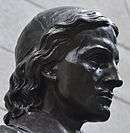Harvard–MIT Program of Health Sciences and Technology
|
| |
| Motto | Integrating science, engineering, and medicine to solve problems in human health |
|---|---|
| Established | 1970 |
| Location | Cambridge, Massachusetts, United States |
| Affiliations | MIT, Harvard University |
| Website |
hst |
Coordinates: 42°21′33″N 71°05′43″W / 42.3592539°N 71.0953229°W
The Harvard–MIT Program in Health Sciences and Technology, or HST, is one of the oldest and largest biomedical engineering and physician-scientist training programs in the United States. It was founded in 1970 and is the longest-standing functional collaboration between Harvard University and the Massachusetts Institute of Technology (MIT).
HST's interdisciplinary educational program brings engineering as well as the physical and biological sciences from the scientist's bench to the patient's bedside. Conversely, it brings clinical insight from the patient's bedside to the laboratory bench. In this way, HST students are trained to have deep understanding of engineering, physical sciences, and the biological sciences, complemented with hands-on experience in the clinic or in industry; and they become conversant with the underlying quantitative and molecular aspects of medicine and biomedical science. Within the division, more than 300 graduate students work with eminent faculty and affiliated faculty members from throughout the MIT and Harvard communities.[1] HST is also the home of the Laboratory of Computational Physiology (LCP) which hosts the MIMIC II database and PhysioNet.
HST is a part of MIT's Institute for Medical Engineering and Science and 1 of 5 societies at Harvard Medical School.
Notable alumni
- David Ho
- Mark McClellan
- Peter Diamandis
- Robert Satcher
- Atul Butte
- Annette Taberner
- Roozbeh Ghaffari
Notable faculty
- Robert Langer, Institute Professor, MIT[2]
- Mehmet Toner, Professor[3]
- George M. Church, Professor[4]
- Roger Mark, Professor[5]
- Elazer Edelman, Professor[6]
- Sangeeta Bhatia, Professor[7]
References
- ↑ "About HST". Retrieved March 20, 2015.
- ↑ "Langer Lab: Professor Robert Langer". Web.mit.edu. 2011-08-03. Retrieved 2012-04-17.
- ↑ "Mehmet Toner". Hst.mit.edu. Retrieved 2015-03-20.
- ↑ "George Church". Arep.med.harvard.edu. 2010-01-04. Retrieved 2012-04-17.
- ↑ "Roger G. Mark". Hst.mit.edu. Retrieved 2015-03-20.
- ↑ "Elazer Edelman's Laboratory, MIT". Web.mit.edu. Retrieved 2012-04-17.
- ↑ "Sangeeta Bhatia's Laboratory, MIT". lmrt.mit.edu. Retrieved 2014-02-05.

